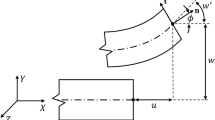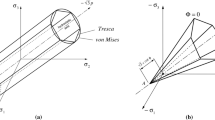Abstract
The discrete element method (DEM) has attractive features for problems with severe damages, but lack of theoretical basis for continua behavior especially for nonlinear behavior has seriously restricted its application. The present study proposes a new approach to developing the DEM as a general and robust technique for modeling the elastoplastic behavior of solid materials. New types of connective links between elements are proposed, the inter-element parameters are theoretically determined based on the principle of energy equivalence and a yield criterion and a flow rule for DEM are given for describing nonlinear behavior of materials. Moreover, a numerical scheme, which can be applied to modeling the behavior of a continuum as well as the transformation from a continuum to a discontinuum, is obtained by introducing a fracture criterion and a contact model into the DEM. The elastoplastic stress wave propagations and the tensile failure process of a steel plate are simulated, and the numerical results agree well with those obtained from the finite element method (FEM) and corresponding experiment, and thus the accuracy and efficiency of the DEM scheme are demonstrated.
Similar content being viewed by others
References
Zhang D.L., Tan Q.M., Zhao C.X., Yang Y.M., Ge X.Z., Zhang Q.M.: Experimental investigations of hypervelocity impact onto aluminum dual-plate structure. Acta Mech. Sin. 8, 374–382 (1992)
Cundall P.A.: A computer model for simulating progressive large scale movement in block rock system. Symp. ISRM. Proc. 2, 129–136 (1971)
Mohammadi S., Owen D.R.J., Peric D.: A combined finite/discrete element algorithm for delamination analysis of composites. Finite Elem. Anal. Des. 289, 321–336 (1998)
Onate E., Rojek J.: Combination of discrete element and finite element methods for analysis of geomechanics problems. Comput. Methods Appl. Mech. Eng. 193, 3087–3128 (2004)
Wang F.J., Feng Y.T., Owen D.R.J., Zhang J., Liu Y.: Parallel analysis of combined finite/discrete element systems on PC cluster. Acta Mech. Sin. 20, 534–540 (2004)
Loring L.J., Brady B.H.G., Cundall P.A.: Hybrid distinct element- boundary element analysis of jointed rock. Int. J. Rock Mech. Mining Sci. Geomech. Abstract 23, 303–312 (1986)
Tadahiko K., Yasuhiro K.: A new discrete model for analysis of solid mechanics problems. J. Seisan Kenkyu 29, 288–290 (1977)
Sawamoto Y., Tsubota H., Kasai Y., Koshika N., Morikawa H.: Analytical studies on local damage to reinforced concrete structures under impact loading by discrete element method. Nucl. Eng. Des. 179, 157–177 (1998)
Liu K., Gao L., Tanimura S.: Application of discrete element method in impact problems. JSME Int. J. Ser. A 47, 138–145 (2004)
Liu K., Gao L.: The application of discrete element method in solving three dimensional impact dynamics problems. Acta Mech. Sol. 16, 256–261 (2003)
Liu K., Liu W.: Application of discrete element method for continuum dynamic problems. Arch. Appl. Mech. 76, 229–243 (2006)
Cundall P.A., Strack O.D.L.: A discrete numerical model for granular assemblies. Geotechnique 29, 47–65 (1979)
Livermore Software Technology Corporation: LS-DYNA keyword user’s manual. California, Livermore Software Technology Corporation (2003)
Author information
Authors and Affiliations
Corresponding author
Additional information
The project supported by the National Natural Science Foundation of China (10572002 and 10732010).
Rights and permissions
About this article
Cite this article
Cheng, M., Liu, W. & Liu, K. New discrete element models for elastoplastic problems. Acta Mech Sin 25, 629–637 (2009). https://doi.org/10.1007/s10409-009-0271-5
Received:
Revised:
Accepted:
Published:
Issue Date:
DOI: https://doi.org/10.1007/s10409-009-0271-5




